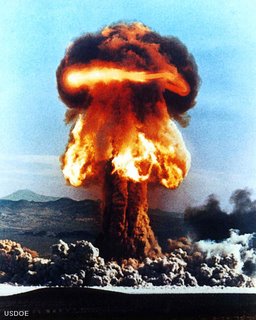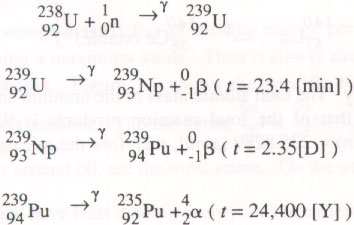
An Adult Nightmare: New York City will vanish in a pillar of nuclear fire within four years.
All the pieces are in place, if you choose to pay attention. The biggest hurdle was cleared by Iran just last month when they announce that Iranian scientist have succeeded in producing a “small” amount of enriched uranium. This is “THE” big step to creating a nuclear weapon. It’s not the engineering, the cost, the time, the effort, or the will. Getting the Uranium is the battle. First let get a crash course in Modern Physics 101.
Uranium is a naturally occurring element that comes in several different isotopes (flavors, if you will). Chemical they are all the same, but some have more neutrons in the center of the atoms than others. The two isotopes we are most concerned with are Uranium 235 (U-235) and Uranium 238 (U-238). For every thousand uranium atoms only seven of are U-235, so only about 0.7% of naturally occurring uranium atoms can be used for fission. Since theses two types atoms are chemical the same, you have to find a way of physical separate them. U-238 is slightly heavier than U-235. So you can separate the flavors of atom physically by weight (mass). In the past, this would take a lot of work. (It took the United State over two years scrap enough U-235 together for the first atomic bomb dropped on Hiroshima.) This is no longer the case due to a very clever scientist named Gernot Zippe. He came up with the bright idea to take Uranium and convert it into a gaseous from, Uranium Hexafluoride, then sort the uranium by weight. This is what a gas centrifuge does. By spinning the uranium gas, the lighter U-235 can be separated from it’s non-fissionable sister U-238. The act of concentrating fissionable nuclear material is called enrichment.
Most light water reactor require 5% of the uranium in a fuel pellet to be U-235, that is called enriched uranium. There are some other types of reactors that need the concentration of Uranium 235 to be as high as 20 percent and weapons grade uranium is 90 percent U-235. Gathering the material is the hard part, building a atomic weapon is trivial, especially if you don’t have to put it in a plane or in the nose cone of a missile.
The simplest atomic weapon is a gun type bomb, sillier to the device use at the end of the Second World War. Basically, you take two large pieces of Uranium 235 and smash them together. One piece is the target. The other piece is the “bullet”. You can smash the “bullet” into the target by using high explosives. What makes this design so dangerous is how simple it is. The whole weapon would fit very nicely into a standard shipping container. Even if you completely mess up the design the explosives will scatter the uranium all over the place contaminating hundreds of square city blocks. If the device works the death toll could be in the hundred of thousands if not millions.
I’m not saying Iran, Iraq, or any other nation would be stupid enough to destroy a major city. However, having a less than stable nation producing large quantities of uranium 235 without very tight regulation and safe guards would be a very bad idea.
Building a weapon is no problem. Getting it in a shipping container is just a matter of bribing a bored, greedy longshoreman. Just tell him it x-rated DVD’s and he’ll let it right through. Just take the example of the Chinese foreign nationals who smuggled themselves into Seattle. This certainly put a new spin on a foreign company trying to get a contract to run some of the United States largest shipping ports.
Maybe I’m just paranoid.

One thing I forgot to mention is how useful Uranium 238 can be. Normally, U-238 is not fissionable. However, that does not make it worthless. A quick look at any periodic table will tell you that all the elements listed after Uranium are artificial, in other words there are created in a breeder reactor or particle accelerator. These transuranium elements all start with a base of Uranium. By bombarding a target Uranium atom with neutrons or alpha particles you make the all the elements heavier than Uranium. All of theses elements are highly radioactive and some or so unstable they only exist for fractions of a second before decaying into something more stable. However, there are some useful products gained from this process. The most useful of theses transuranic element is fissionable Plutonium. A breeder reactor converts Uranium (or Thorium) into Plutonium. Plutonium can be used in reactors for power, or for making nuclear weapons. (Aside: The second atomic weapon used by the United States in World War II was a plutonium device, the infamous “Fat Man”.) What makes Uranium-238 so useful is the fact it can be used in a breeder reactor to make Plutonium.
Have a nice day. Please continue consuming the caffeinated beverage of your choice.










